I am currently rendering a camera preview using GL ES 2.0 on android to a SurfaceTexture, rendering it with opengl, then transferring it to a media codec's input surface to for recording. It is displayed to the user in a surface view and by setting that surface view's aspect ratio the camera preview is not distorted based on screen size.
The recording is in portrait, but at some point the incoming texture will start coming in landscape, at which point I'd like to zoom out and display it as a "movie" stretched wide to fit to the edge of the screen horizonatally with black bars on the top and bottom to maintain the aspect ratio of the texture.
The drawing code in onDrawFrame is pretty simple. The link has the rest of the setup code for shaders and the like but it's just setting up a triangle strip to draw.
private final float[] mTriangleVerticesData = {
// X, Y, Z, U, V
-1.f, -1.f, 0, 0.f, 0.f,
1.f, -1.f, 0, 1.f, 0.f,
-1.f, 1.f, 0, 0.f, 1.f,
1.f, 1.f, 0, 1.f, 1.f,
};
public static final String VERTEX_SHADER =
"uniform mat4 uMVPMatrix;\n" +
"uniform mat4 uSTMatrix;\n" +
"attribute vec4 aPosition;\n" +
"attribute vec4 aTextureCoord;\n" +
"varying vec2 vTextureCoord;\n" +
"void main() {\n" +
" gl_Position = uMVPMatrix * aPosition;\n" +
" vTextureCoord = (uSTMatrix * aTextureCoord).xy;\n" +
"}\n";
private float[] mMVPMatrix = new float[16];
private float[] mSTMatrix = new float[16];
public TextureManager() {
mTriangleVertices = ByteBuffer.allocateDirect(
mTriangleVerticesData.length * FLOAT_SIZE_BYTES)
.order(ByteOrder.nativeOrder()).asFloatBuffer();
mTriangleVertices.put(mTriangleVerticesData).position(0);
mTriangleHalfVertices = ByteBuffer.allocateDirect(
mTriangleVerticesHalfData.length * FLOAT_SIZE_BYTES)
.order(ByteOrder.nativeOrder()).asFloatBuffer();
mTriangleHalfVertices.put(mTriangleVerticesHalfData).position(0);
Matrix.setIdentityM(mSTMatrix, 0);
}
onDrawFrame(){
mSurfaceTexture.getTransformMatrix(mSTMatrix);
GLES20.glUseProgram(mProgram);
checkGlError("glUseProgram");
GLES20.glActiveTexture(GLES20.GL_TEXTURE0);
GLES20.glBindTexture(GLES11Ext.GL_TEXTURE_EXTERNAL_OES, 0);
GLES20.glBindTexture(GLES11Ext.GL_TEXTURE_EXTERNAL_OES, mTextureID);
mTriangleVertices.position(TRIANGLE_VERTICES_DATA_POS_OFFSET);
GLES20.glVertexAttribPointer(maPositionHandle, 3, GLES20.GL_FLOAT, false,
TRIANGLE_VERTICES_DATA_STRIDE_BYTES, mTriangleVertices);
checkGlError("glVertexAttribPointer maPosition");
GLES20.glEnableVertexAttribArray(maPositionHandle);
checkGlError("glEnableVertexAttribArray maPositionHandle");
mTriangleVertices.position(TRIANGLE_VERTICES_DATA_UV_OFFSET);
GLES20.glVertexAttribPointer(maTextureHandle, 2, GLES20.GL_FLOAT, false,
TRIANGLE_VERTICES_DATA_STRIDE_BYTES, mTriangleVertices);
checkGlError("glVertexAttribPointer maTextureHandle");
GLES20.glEnableVertexAttribArray(maTextureHandle);
checkGlError("glEnableVertexAttribArray maTextureHandle");
Matrix.setIdentityM(mMVPMatrix, 0);
GLES20.glUniformMatrix4fv(muMVPMatrixHandle, 1, false, mMVPMatrix, 0);
GLES20.glUniformMatrix4fv(muSTMatrixHandle, 1, false, mSTMatrix, 0);
GLES20.glDrawArrays(GLES20.GL_TRIANGLE_STRIP, 0, 4);
checkGlError("glDrawArrays");
GLES20.glFinish();`
}
Things I've tried that haven't quite worked: Scaling mMVPMatrix or mSTMatrix to zoom in. I can zoom in, so I can get the "center slice" of the landscape video to display without distortion, but this cuts off a huge 40% portion of the video, so it isn't a great solution. Zooming out by scaling these matricies causes the texture to repeat the pixel on the edge because of the clamp to edge behavior.
Halving the x,y,z parts of mTriangleVerticesData gives some of the desired behavior as seen in the screenshot below, exact aspect ratio aside. The center part of the picture is halved and centered, as expected. However, the texture is repeated to the left, right, and bottom, and there is distortion to the top left. What I want is the center to be as it is, with black/nothing surrounding it.
I could scale out then translate mMVPMatrix or mSTMatrix and then change my shader to display black for anything outside (0,1) but eventually I want to overlay multiple textures on top of one another, like a full size background and partial size foreground texture. To do this I must eventually figure out how to only display a texture in a portion of the available space, not just manipulate the texture so it looks like that's what's happening.
Thanks for reading all that. Any help, suggestions, or wild guesses are appreciated.
